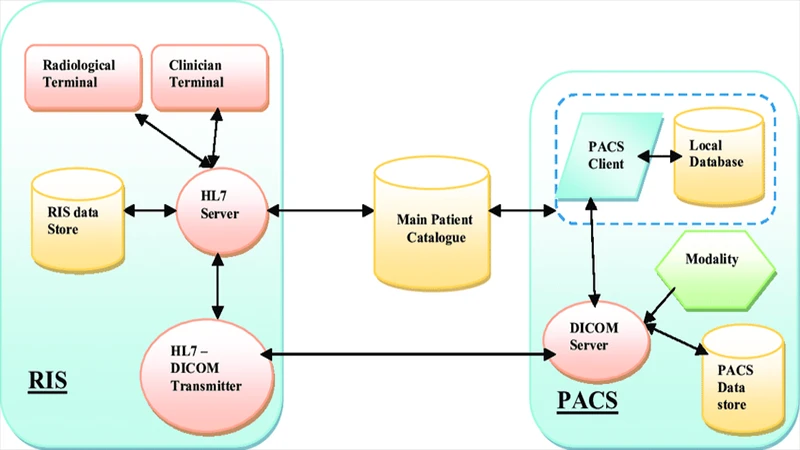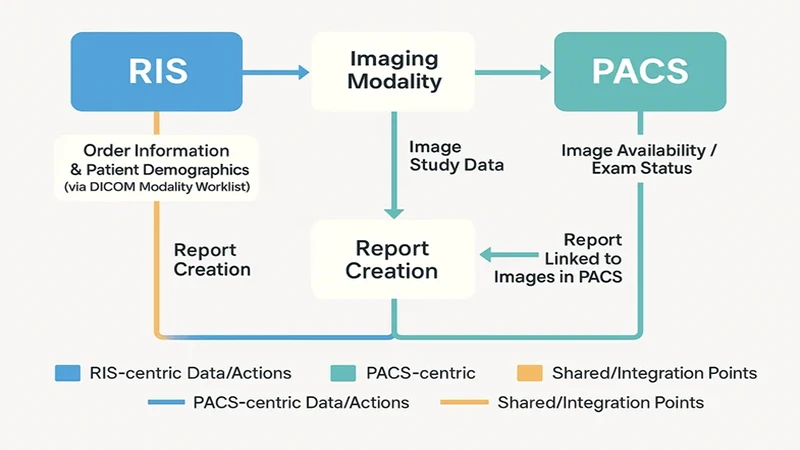An Introduction to PACS and RIS: The IT Backbone of Radiology
Behind every modern radiology department is a sophisticated network of software that manages everything from patient scheduling to image storage. The two most critical components of this digital ecosystem are the PACS and the RIS. While they work together seamlessly, they have very different functions. Understanding the role of each is essential for anyone working in medical imaging.
RIS (Radiology Information System): The Workflow Manager
Think of the RIS as the "brain" or the administrative hub of the department. It is a software system that manages all the textual data and workflow related to a patient's journey through radiology.
Key functions of a RIS include:
- Patient Scheduling: Booking appointments for CT, MRI, X-ray, and other exams.
- Order Management: Receiving exam orders from physicians and managing patient registration.
- Worklist Generation: Providing technologists with a real-time list of patients to be scanned (the "modality worklist").
- Billing and Reporting: Managing billing codes and tracking patient statuses.
- Report Dictation & Transcription: Providing a platform for radiologists to dictate their findings and for those reports to be transcribed and finalized.
In short, the RIS handles everything **except the images themselves**. It manages the who, what, when, where, and why of every exam.

PACS (Picture Archiving and Communication System): The Image Library
Think of the PACS as the "heart" or the digital filing cabinet of the department. Its entire purpose is to manage the medical images.
Key functions of a PACS include:
- Image Acquisition: Receiving DICOM images directly from the imaging modalities (CT, MRI scanners, etc.).
- Archiving and Storage: Securely storing vast quantities of image data for both short-term access and long-term legal requirements.
- Distribution and Viewing: Providing a network for radiologists to access and view images on high-resolution diagnostic workstations, and for clinicians to view them throughout the hospital.
- Integration: Communicating with other systems, primarily the RIS, to ensure images are correctly associated with the right patient and report.
The PACS is where the actual pixels are stored, viewed, and manipulated. When a radiologist opens a study to read it, they are interacting with the PACS.
How They Work Together: A Seamless Handoff
The synergy between RIS and PACS is what makes a modern radiology department efficient. Here’s a typical workflow:
- A physician places an order for a CT scan, which enters the RIS.
- The patient is scheduled and registered in the RIS.
- The technologist sees the patient on their modality worklist, which comes from the RIS.
- The technologist performs the CT scan. The images are sent from the scanner to the PACS.
- The PACS automatically queries the RIS to get patient and exam details to attach to the images.
- A radiologist opens the images on a PACS workstation. They read the study and dictate a report using software connected to the RIS.
- The final report is stored in the RIS and linked to the images in the PACS.

Conclusion: The Unseen Engine of Radiology
For technologists, radiologists, and support staff, the RIS and PACS are the essential tools of the trade. The RIS manages the textual data and workflow, while the PACS handles the image data. Their seamless integration, typically using standards like HL7 and DICOM, creates a powerful and efficient system that forms the digital backbone of any modern medical imaging practice, ensuring that the right images are available to the right people at the right time.


Comments